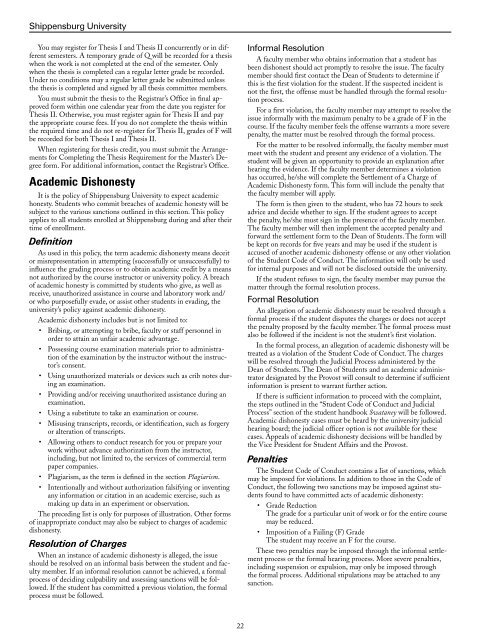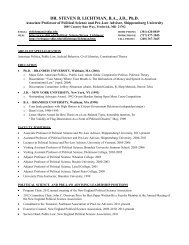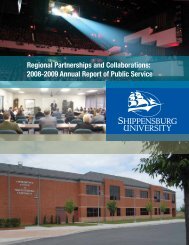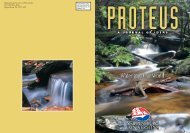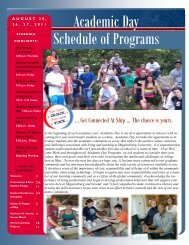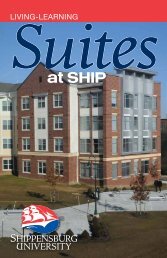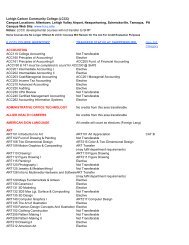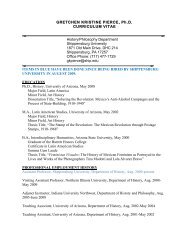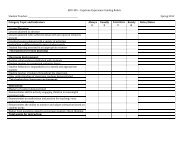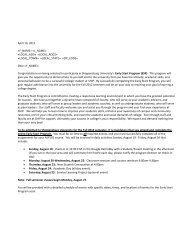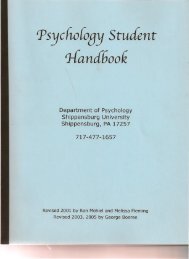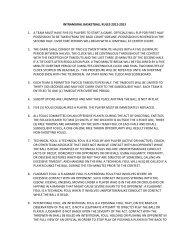Graduate Catalog - Shippensburg University
Graduate Catalog - Shippensburg University
Graduate Catalog - Shippensburg University
Create successful ePaper yourself
Turn your PDF publications into a flip-book with our unique Google optimized e-Paper software.
<strong>Shippensburg</strong> <strong>University</strong>You may register for Thesis I and Thesis II concurrently or in differentsemesters. A temporary grade of Q will be recorded for a thesiswhen the work is not completed at the end of the semester. Onlywhen the thesis is completed can a regular letter grade be recorded.Under no conditions may a regular letter grade be submitted unlessthe thesis is completed and signed by all thesis committee members.You must submit the thesis to the Registrar’s Office in final approvedform within one calendar year from the date you register forThesis II. Otherwise, you must register again for Thesis II and paythe appropriate course fees. If you do not complete the thesis withinthe required time and do not re-register for Thesis II, grades of F willbe recorded for both Thesis I and Thesis II.When registering for thesis credit, you must submit the Arrangementsfor Completing the Thesis Requirement for the Master’s Degreeform. For additional information, contact the Registrar’s Office.Academic DishonestyIt is the policy of <strong>Shippensburg</strong> <strong>University</strong> to expect academichonesty. Students who commit breaches of academic honesty will besubject to the various sanctions outlined in this section. This policyapplies to all students enrolled at <strong>Shippensburg</strong> during and after theirtime of enrollment.DefinitionAs used in this policy, the term academic dishonesty means deceitor misrepresentation in attempting (successfully or unsuccessfully) toinfluence the grading process or to obtain academic credit by a meansnot authorized by the course instructor or university policy. A breachof academic honesty is committed by students who give, as well asreceive, unauthorized assistance in course and laboratory work and/or who purposefully evade, or assist other students in evading, theuniversity’s policy against academic dishonesty.Academic dishonesty includes but is not limited to:• Bribing, or attempting to bribe, faculty or staff personnel inorder to attain an unfair academic advantage.• Possessing course examination materials prior to administrationof the examination by the instructor without the instructor’sconsent.• Using unauthorized materials or devices such as crib notes duringan examination.• Providing and/or receiving unauthorized assistance during anexamination.• Using a substitute to take an examination or course.• Misusing transcripts, records, or identification, such as forgeryor alteration of transcripts.• Allowing others to conduct research for you or prepare yourwork without advance authorization from the instructor,including, but not limited to, the services of commercial termpaper companies.• Plagiarism, as the term is defined in the section Plagiarism.• Intentionally and without authorization falsifying or inventingany information or citation in an academic exercise, such asmaking up data in an experiment or observation.The preceding list is only for purposes of illustration. Other formsof inappropriate conduct may also be subject to charges of academicdishonesty.Resolution of ChargesWhen an instance of academic dishonesty is alleged, the issueshould be resolved on an informal basis between the student and facultymember. If an informal resolution cannot be achieved, a formalprocess of deciding culpability and assessing sanctions will be followed.If the student has committed a previous violation, the formalprocess must be followed.Informal ResolutionA faculty member who obtains information that a student hasbeen dishonest should act promptly to resolve the issue. The facultymember should first contact the Dean of Students to determine ifthis is the first violation for the student. If the suspected incident isnot the first, the offense must be handled through the formal resolutionprocess.For a first violation, the faculty member may attempt to resolve theissue informally with the maximum penalty to be a grade of F in thecourse. If the faculty member feels the offense warrants a more severepenalty, the matter must be resolved through the formal process.For the matter to be resolved informally, the faculty member mustmeet with the student and present any evidence of a violation. Thestudent will be given an opportunity to provide an explanation afterhearing the evidence. If the faculty member determines a violationhas occurred, he/she will complete the Settlement of a Charge ofAcademic Dishonesty form. This form will include the penalty thatthe faculty member will apply.The form is then given to the student, who has 72 hours to seekadvice and decide whether to sign. If the student agrees to acceptthe penalty, he/she must sign in the presence of the faculty member.The faculty member will then implement the accepted penalty andforward the settlement form to the Dean of Students. The form willbe kept on records for five years and may be used if the student isaccused of another academic dishonesty offense or any other violationof the Student Code of Conduct. The information will only be usedfor internal purposes and will not be disclosed outside the university.If the student refuses to sign, the faculty member may pursue thematter through the formal resolution process.Formal ResolutionAn allegation of academic dishonesty must be resolved through aformal process if the student disputes the charges or does not acceptthe penalty proposed by the faculty member. The formal process mustalso be followed if the incident is not the student’s first violation.In the formal process, an allegation of academic dishonesty will betreated as a violation of the Student Code of Conduct. The chargeswill be resolved through the Judicial Process administered by theDean of Students. The Dean of Students and an academic administratordesignated by the Provost will consult to determine if sufficientinformation is present to warrant further action.If there is sufficient information to proceed with the complaint,the steps outlined in the “Student Code of Conduct and JudicialProcess” section of the student handbook Swataney will be followed.Academic dishonesty cases must be heard by the university judicialhearing board; the judicial officer option is not available for thesecases. Appeals of academic dishonesty decisions will be handled bythe Vice President for Student Affairs and the Provost.PenaltiesThe Student Code of Conduct contains a list of sanctions, whichmay be imposed for violations. In addition to those in the Code ofConduct, the following two sanctions may be imposed against studentsfound to have committed acts of academic dishonesty:• Grade ReductionThe grade for a particular unit of work or for the entire coursemay be reduced.• Imposition of a Failing (F) GradeThe student may receive an F for the course.These two penalties may be imposed through the informal settlementprocess or the formal hearing process. More severe penalties,including suspension or expulsion, may only be imposed throughthe formal process. Additional stipulations may be attached to anysanction.22


